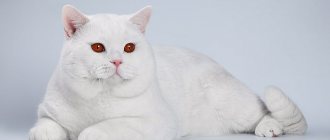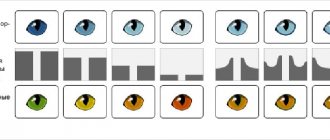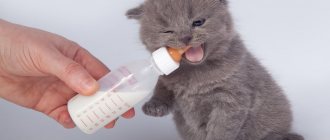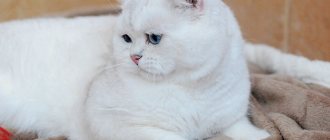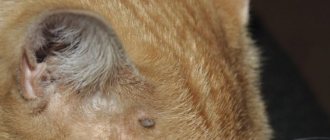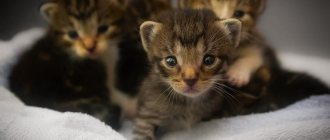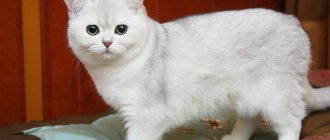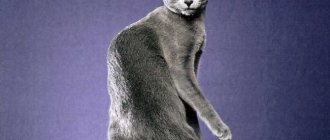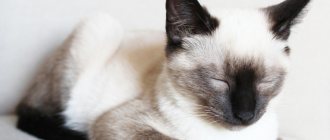BRITISH TABBY: COLOR STANDARD
British tabbies, regardless of the pattern on the coat, must have the following elements in their color (the exception is the ticked color - it has no pattern):
- the letter "M" on the forehead;
- “necklaces” on the chest;
- stripes on the paws;
- tail rings;
- one or two rows of spots on the belly;
- A contrasting tabby pattern is required;
- a light spot on each ear on the outside;
- eyeliner and nose to match the main color.
Photo: British spotted tabby cat, spotted chocolate color BRI b 24
British tabby color is based on a good contrast pattern; if it is blurred, it is rejected by experts. Most likely there was an incorrect mating, where one of the parents was a solid color and the other was a tabby.
The eye color of a British cat must correspond to the standard of the main color (most often golden, less often green or blue).
Cat colors: what are they and how are they bred?
The color of a cat implies not only the color of its fur, but also the pattern on it (spots, rings, stripes, stains, etc.). There are only a few main genes responsible for cat colors (solid color, diluents, etc.), but they can be made in a variety of combinations, like a children's construction set. This allows you to create countless options for breeding the desired trait, wisely using a set of parental genes (dominant and recessive).
The pattern on a cat's skin may vary
BRITISH SHORTHAIR TABBY CAT: VARIETIES OF COLOR PATTERNS
Shorthair British tabby cat, may be one of the following color subspecies:
- ticked;
- spotted (leopard);
- striped (brindle);
- marble.
Let's look at all types of colors schematically.
Knitting features
The British merle color is one of the most difficult to breed due to the high degree of moire among the offspring. Felinologists still cannot track the pattern of appearance of vague patterns. The most common reason is the crossing of a merle parent with a solid-colored Briton.
British marbled cats can only be knitted with each other
Everything is explained by the genetics of color - the gene responsible for the merle pattern is recessive, and the gene for uniform color easily overlaps it. Therefore, in order to preserve breed characteristics, it is important to breed only between British Marbleds. In exceptional cases, crossing with representatives of the breed that have a tiger (mackerel) color is allowed.
TICKED BRITISH COLOR
The ticked color of the British cats is similar in appearance to the solid color, although it belongs to the Tibby color of British cats. The color should be even and only the upper part should look like “spraying”.
By spreading the fur, you can see that each hair has stripes. The undercoat corresponds to the color of the coat (chocolate, blue, lilac, etc.).
Of all the tabby markings in the ticked color of a British cat, only the letter “M” is present on the forehead and drawn curls on the cheeks. All other stripes, spots, rings on the tail and “necklaces” on the chest are rejected.
This color is very similar to the shaded and veiled one, only it has a higher intensity of the main color. Eyes are orange, golden or green.
Photo: golden ticked British tabby kitten BRI ny 25 64
Plain (solid)
The color of Scottish Fold cats is monochromatic and they should not have any other color. The fold-eared cat can be of the following colors: white and black, chocolate and lilac, blue and red, cream, fawn and cinnamon. The most popular color in the world among solid Scottish cats is blue. These are the majority of cats.
White
The white Scottish Straight cat can have different eyes, from blue and bright orange to rich amber and copper. Kittens of this variety remain white for the rest of their lives. If kittens have spots, then an adult cat remains white for the rest of its life.
Black
The Scottish Fold black cat is mostly bright in color. A couple of white hairs are acceptable, but if the cat has large red and brown patches, then it is not a purebred.
Black Scottish Fold cats should be bright black in color and their ears, like all fold-eared cats, should be pressed to the head, unlike straight-eared cats. A straight-eared black cat always has its ears erect.
Chocolate
The chocolate Scottish Fold looks impressive. The chocolate color is quite rare. Brown fold kittens should have a smooth, uniform coat of chocolate color. The dark brown coloring adds nobility to the cat.
A brown cat gets this color if he has chocolate, chocolate bicolor or chocolate color points in his pedigree. Chocolate Scottish kittens always delight their owners. They look very cool against a light background.
Lilac (lavender)
A lilac long-eared cat gets this color if he has either lilac color points or lilac in his pedigree. The lilac coloration goes well with orange, copper or amber colored eyes and a light brown nose. This color is also called coffee with milk.
Blue color (blue)
The Scots Blue can have a coat color of many shades of blue. Some cats may have a fur color closer to gray, and some closer to blue. Each hair must be saturated, then the coat will be perfectly blue.
SPOTTED TABBY, LEOPARD COLOR BRITISH
According to the standard, the spotted color of the British must contain the letter “M” on the forehead, “necklaces”, stripes on the paws, rings on the tail, spots on the belly, a contrasting pattern, eyeliner and nose.
The British spotted cat can also be called Spotted tabby or leopard, which, in principle, is the same thing. The color must invariably include: the letter “M” on the forehead, “necklaces”, stripes on the paws, rings on the tail, spots on the belly, a contrasting pattern, eyeliner and nose, all according to the standard. The spotted color is the most common of all tabby colors. The British spotted cat looks elegant and looks like a leopard, which is why it received this second name for the color. British spotted kittens can be born from parents of any tabby color. Eyes can be copper or green (green eye color is characteristic of golden and sometimes silver colors).
Photo of a British tabby kitten, black silver spotted color BRI ns 24
History of the Scottish Straight breed
The Scottish Straight breed is the same as the Scottish Fold, only with a modified structure of the auricle. Simply put, folds are lop-eared, straights are straight-eared, without a characteristic crease. This is the only exterior feature that distinguishes straights from folds.
The Scottish Shorthair cat is considered the youngest breed. The first kitten with flattened ears appeared in Scotland on one of the farms in the 60s. The ancestor of the Scottish cat had no pedigree and was an ordinary cat that chased rodents around barns.
According to official data, the first breeder of the breed was William Ross, a peasant who took into care a kitten from a fold-eared cat. Later, breeders joined the breeding process. Experts noticed an interesting feature: kittens with straight ears periodically appeared in litters of purebred Scottish cats. They were in no hurry to separate them into a separate breed, since they considered straight ears to be a defect, and such kittens were not popular. However, nature itself entered the arena.
Soon, breeders noticed that attempts to consolidate lop ears as a breed trait led to a deterioration in the health of the animals. The gene that is responsible for flattened ears inhibits the function of the bone apparatus, which has led to thickening of the bones and osteochondrodysplasia. The breeders decided to look for “fresh blood” in order to reduce the number of genetic pathologies.
Using the outcrossing method, breeders found that the healthiest offspring are obtained from crossing a Fold female and a Straight male. It was this discovery that drew the attention of felinologists to the straight-eared Scots. In 2004, the Scottish Straight breed was officially recognized by members of the World Cat Federation, which in turn fueled interest in straight-eared cats. The official breed code is SFS71.
Interesting. Scottish cats love to stand on their hind legs, like gophers, looking at something interesting. Another favorite pose of these wonderful purrs is sitting on the sofa or near the wall, with their front legs folded over their belly and their hind legs spread out.
BRITISH STRIPED COLOR (BRINCH, MACKERL)
The striped color of the British (British brindle tabby) must comply with all the same standards as the spotted one, only the pattern on the back and sides must have clear and uninterrupted stripes. In the color of a British Tabby Shorthair cat, the stripes should start at the spine and extend all the way to the paws. The stripes of a British brindle cat are narrow and frequent (and it is believed that the more often the better). Mackerel stripes (mackerel) should not intersect each other, be strictly vertical and always contrasting.
A brindle (striped) British kitten, even with very clear stripes, can “stretch” its color by adulthood and, if the stripes begin to be interrupted anywhere, the color is reviewed by experts and assigned - spotted. The full color of a British brindle kitten will be formed only by the age of one year (other tabby colors are not subject to such changes and most often do not change the appearance of the tabby pattern in adulthood).
British tabby cats are not as common as spotted cats, but more common than marbled cats.
The eye color of British tabby cats can be copper (golden, orange) or green (gold, occasionally silver).
Chocolate tabby British kitten: photo of California
Breeding
Sexual maturity in Scottish beauties occurs at 8-10 months, but the first mating is carried out no earlier than 1.3 years. Early mating often results in protracted labor and death of the offspring, and in males it leads to a shortening of the fertile period.
The first heat of cats occurs after a year. She needs to be passed and mated for the second or third heat.
The intervals between estrus vary and depend on the season. Breeders have noticed that purebred cats have much fewer periods of heat throughout the year than domestic cats.
The breeding partner must be selected in advance, following the rules established by the WCF. Ideally, the cat should be the same color as the female cat. It is not recommended to mix chinchilla with tabby, blue with lilac, etc. From such unions, kittens are born with uneven color or an indeterminate iris color.
Folds are mated exclusively with straights! The cat is brought into the cat's territory on the second day of estrus. First, the couple gets acquainted, the male courtes his lady with all his might, and the female explores the territory. The success of mating largely depends on the cat. Some very impressionable “grooms” are at a loss from the “bride’s” aggression, others do not even blink in response to the evil hiss.
The couples meet in a civilized manner. For some time, it is better to keep the animals on opposite sides of the door. This way they will receive information in doses. As soon as the partners get to know each other, the barrier between them can be removed. The duration of the mating itself should not exceed three days. Pregnancy lasts 9 weeks. After mating, the female becomes very calm.
The first signs of pregnancy appear after 2-3 weeks: the nipples turn pink and swell. At week 5, the belly is rounded and weight gain is observed. You need to prepare for childbirth in advance: buy disposable diapers, scissors for cutting the umbilical cord, disinfectants. You can also schedule the birth with your veterinarian, especially if your cat is giving birth for the first time.
BRITISH MARBLE COLOR (MARBLE)
The British merle color is a very bright, beautiful color, perhaps the most complex in the tabby series. Marbled British cats wear beautiful patterns on their backs (2 stripes along the ridge, closed large circles on the sides, inside of which there is a clear large painted spot. And this entire pattern should not intersect or be interrupted. Also, a British marbled tabby cat has a butterfly pattern on the back of its head, patterns on the cheeks, starting from the corners of the eyes, on the forehead the letter "M". In addition, the British marble cat has closed "necklaces" on the chest (the larger the better), clear rings on the paws and tail. The British marble cat is very valued among breeders for its beautiful design, especially if the color is drawn correctly.
A British merle color may not be contrasting, in which case the color is rejected.
Photo: British cat Emili black marble on gold BRI ny 22 64
The character of the British marbled cat is no different from all other colors, although often future owners are interested in it, thinking that it is a separate breed of cat.
The marbled color of British kittens is visible from birth and is already quite contrasting. The necessary stripes, circles, and rings are clearly visible. The pattern of a British marbled kitten (British marbled kitten) may blend in a little with the main color of the coat, do not worry, most often by 2 months everything evens out and the color becomes most expressive.
Rare colors of Scottish cats
Many readers ask what the rarest and most expensive colors of Scottish cats are. Today there are no problems finding any color, however, among breeders trying to get the maximum variety of colors of kittens from one cat, tortoiseshell cats are very much appreciated, because... they carry the genes of both the red and black series at once. Among ordinary people who are not involved in breeding, the so-called precious colors - gold and silver - are now in fashion. However, these colors can no longer be called rare, since such cats are becoming more and more popular due to their popularity.
And for those who are in search of what is the best color of Scottish cats, let’s say: this is the color that you like, because you live with this cat. You may become interested in cats whose color is as close to natural as possible, that is, spotted or tabby. Or maybe you will like red (ginger) cats, because... they please the eye and improve your mood with their appearance. Whatever color you choose, the main thing is that you like it.
BRITISH TABBY CATS: TYPES OF COLOR
In British tabby cats, the main tone - the color of the coat - is light (for example, red, chocolate, lilac, etc.), but the pattern is made in a dark color (black, blue, red). The colors of British tabby cats (or tabby/tabby) are encoded with the numbers 22/23/24/25, which are added after the main color color.
British tabbies can be of the following types:
- black ticked/spotted/striped/marbled BRI n 25/24/23/22 (BROWN TABBY);
- blue ticked/spotted/striped/marbled BRI a 25/24/23/22 BLUE TABBY;
- lilac ticked/spotted/striped/marbled BRI c 25/24/23/22 LILAC TABBY;
- chocolate ticked/spotted/striped/marbled BRI b 25/24/23/22 CHOCOLATE TABBY;
- cinnamon ticked/spotted/striped/marbled BRI o 25/24/23/22 CINNAMON TABBY;
- fawn ticked/spotted/striped/marbled BRI p 25/24/23/22 FAVN TABBY;
- red ticked/spotted/striped/marbled BRI d 25/24/23/22 RED TABBY;
- cream ticked/spotted/striped/marbled BRI e 25/24/23/22 CREAM TABBY;
- silver ticked/spotted/striped/marbled BRI s 25/24/23/22 – SILVER TABBY;
- golden ticked/spotted/striped/marbled BRI y 25/24/23/22 GOLDEN TABBY;
- tortoiseshell ticked/spotted/striped/marbled BRI 25/24/23/22;
- bicolor ticked/spotted/striped/marbled BRI 25/24/23/22;
- color-point ticked/spotted/striped/marbled BRI 25/24/23/22.
GENETICS OF COLOR
The tabby pattern is due to the A gene - agotti.
You can often hear the phrase from. What does it mean? — Genetically, all cats (yes, all cats, of all breeds and species) have a pattern on their body, but the magic gene “not agouti” hides the pattern on the body.
Color formula:
AA - a tabby cat (with a pattern), she will always give birth to kittens with a pattern, regardless of the color of the second sire;
Aa is a tabby cat (with a pattern), she will always give birth to kittens with and without a pattern (plain);
aa is a cat of a single color (without a pattern).
WHAT DOES A TABBY CAT'S HAIR LOOK LIKE?
The tip of the hair is well pigmented, then there is a less saturated section of the hair and so alternates.
There are several types of tabby patterns - brindle, spotted, ticked, marbled.
- Ta – ticked tabby
- T – striped/spotted tabby
- tb – marbled tabby
Color dominance:
- Ta is dominant over T and tb colors
- T is dominant over tb color
- tb - recessive color
INTERESTING TO KNOW
- Most kittens have a visible tabby pattern at birth, even if they are born to solid-colored parents. This confirms that all cats are tabbies.
- If we breed a cat with the recessive allele “aa” (it has an even, solid color) with a tabby cat who has the “Aa” gene, we will get offspring with a tabby pattern and a solid color.
- Two same-colored parents can never produce a tabby kitten.
- From two tabby sires a monochromatic kitten can be born (in the case when the formula of the parents is Aa + Aa - this means that they are carriers of a monochromatic color, being drawn)
- Two ticked parents can produce kittens: ticked, spotted/striped and marbled
- Two spotted/striped parents can produce kittens: spotted/striped and marbled
- Only merle kittens can be born from two merle parents and never spotted/striped or ticked kittens.
TOP 10 popular varieties
Often the tabby or piebald color of a cat is mixed with snow-white. The one-color tone is a kind of “knee socks” on the legs and spots on the belly. The tiger color occupies exactly half of the body, the rest is covered with white.
- Clouded Leopard - The image is similar to lynx fur and resembles marble in combination with a steel color.
- Silver (silver) implies a dark image on a snow-white color.
- Rosette - a variation of piebald coloring, visually the spots resemble rosettes. Most often found in the Bengal breed.
- Blue - a grayish or azure pattern on light wool.
- Brown is distinguished by a dark outline on a red-brown color.
- Black silver is characteristic of the British breed. The main color is silver with black outlines.
- Sil - found mainly in the Thai breed. Pale chestnut spots are located on a cream color.
- Blue, chocolate, lilac, cream, golden points are found with corresponding colors on a pale, light background.
- Red – stands out because the background color is peach.
- Chocolate in Silver – based on a silver-blue background with chocolate outlines.
BRITISH - TABBY COLOR: SPOTTED, BRIDGE (STRIPPED), MARBLE
Here are photos of British cats, cats, tabby kittens. British tabbies are spotted, striped (brindle), marbled.
| British tabby, photo of chocolate silver ticked British kitten BRI bs 25 | Photo of a British tabby kitten: lilac ticked BRI c | British tabby cat, photo of golden ticked Briton BRI ny 25 |
| Photos of British tabby kittens: red ticked color BRI d 25 | British tabby cat, photo of red silver color BRI ds 25 | British cat tabby color, photo of cream silver ticked color BRI es 25 |
British spotted cat cinnamon BRI o 24 | British brindle kitten, photo red British BRI d 23 | British brindle (striped) tabby cat, photo of a chocolate tabby British kitten BRI b 23 |
| British tabby (tiger) cat, photo of black silver British tabby BRI ns 23 | British spotted cat, photo of blue spotted tabby color BRI a 24 | British tabby, photo of lilac spotted British tabby kitten BRI c 24 |
| British tabby, photo of tortoiseshell spotted color BRI f 24 | British tabby cat, photo of chocolate spotted British kitten BRI b 24 | Leopard tabby color, photo of golden spotted British kitten BRI ny 24 |
British tabby, photo of tortoiseshell tabby color BRI q 23 | Marbled British kitten, photo of chocolate marbled British kitten BRI b 22 | British merle kitten, photo fawn harlequin color BRI p 22 |
Marbled British cat, photo cinnamon marbled color BRI o 22 | British tabby cat, photo cream tabby color BRI e 22 | British marble on silver, photo red marble British tabby BRI ds 22 |
British kitten, photo of marbled chocolate color BRI b 22 | British merle cat, photo lilac merle British tabby BRI c 22 | British merle kitten, photo of black golden merle BRI ny 22 64 |
British black marbled on silver, photo of tortoiseshell silver British kitten BRI fs 22 | British blue marble, photo of black blue marble British tabby kitten BRI a 22 | British merle cat on silver, photo of black merle British tabby color BRI ns 22 64 |
| Silver merle Briton, photo of British merle color on silver tabby BRI ns 22 | British tabby, photo color point tabby color BRI a 33 21 | British cat black marbled bicolor, photo of color black silver marbled bicolor tabby BRI ns 03 22 |
Wang
The Van coloring of Scottish pets includes a white coat with a colored tail and several spots on the head. If there are large spots on the paws and back, this is considered an undesirable sign for a purebred Scot. And a cat with dark red patterns is called a red van.
The color of the spots can be single-color or tabbed.
BRITISH TABBY KITTENS
British tabby kittens can only be born from parents of this color. Those. at least one parent must be a tabby (with a pattern). A British tabby/tabby kitten should have a fairly contrasting pattern from birth. It must be remembered that over time, the color of British tabby cats “erodes” as the kitten grows, so, for example, a brindle color can turn out to be a spotted color. The full tabby color of British cats is formed by one year.
| In our cattery you can “buy a real British kitten.” We have many different colors, we will help you choose and answer all your questions! |
About character
In the photo , cats of the British breed always delight with their calm gaze.
This look conveys the true English character: delicate and unobtrusive. Cats love their owner, but try to remain as independent as possible. They prefer to spend time quietly, enjoying warmth and comfort.
Most British marbled cats are playful. But they are reluctant to be held, especially by strangers. Although cats do not show aggression, even if something happens against their will. True aristocrats always show amazing restraint, which is why their owners love them so much!
Health
The British Shorthair cat is not susceptible to hereditary diseases. She is in excellent health. However, this does not mean that vaccination and preventive examinations by a veterinarian can be neglected.
It must be taken into account that sexual and physical maturation in general occurs late in the British - around the age of four. It is at this age that kittens turn into adult cats: they show all the solidity and massiveness provided for by the standards. There is no point in sounding the alarm or suspecting dystrophy until this moment.
In comfortable conditions, a Briton lives on average 15 years. However, there are record holders in the breed whose age has exceeded 20. The reasons are simple: lack of stress, active cat life, balanced food and, of course, unconditional love. The well-being of the British largely depends on feeling like a member of the family.
